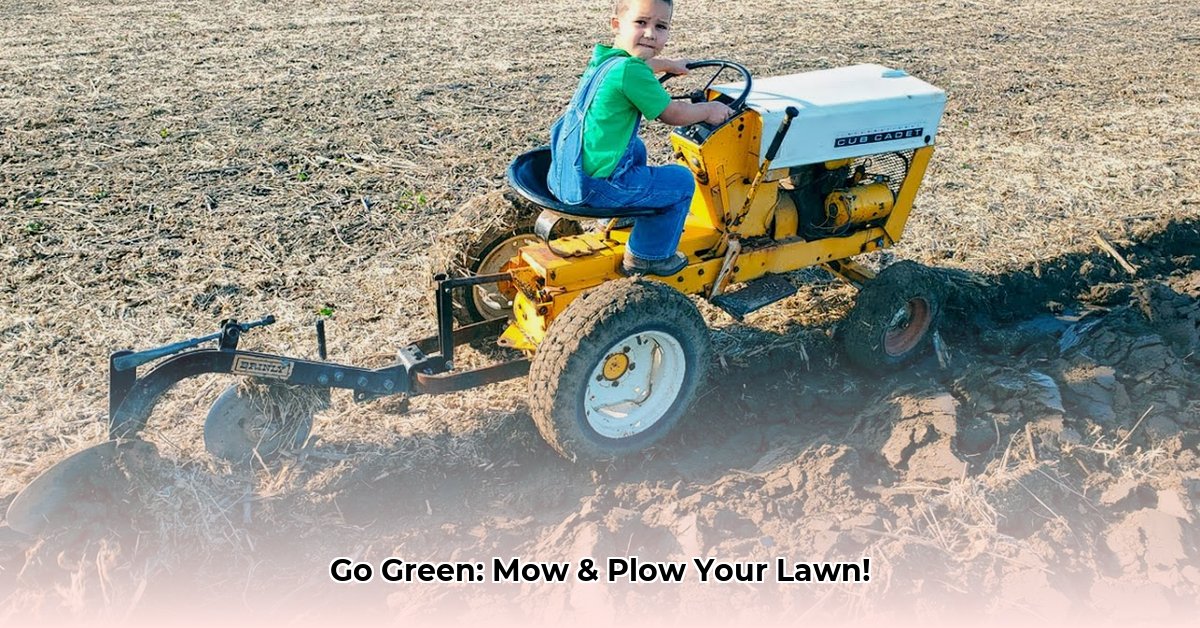
Choosing the Right Lawn Tractor for Snow Removal
Using your lawn tractor for snow removal offers cost-effectiveness and convenience, but it's crucial to choose the right model. Engine power is paramount; a smaller engine struggles with heavy snow, while a more powerful engine tackles challenging conditions with ease. Consider your average snowfall and the size of your driveway. Four-wheel-drive (4WD) offers superior traction on icy or sloped surfaces, significantly improving safety and efficiency compared to two-wheel drive (2WD), which is suitable only for lighter snow and flatter areas. Blade size impacts snow removal speed; a wider blade clears more snow quickly, but requires a more powerful engine. Striking a balance between speed and fuel efficiency is key. For even more eco-friendly options, consider exploring electric options.
Here's a comparison of potential options, illustrating the impact of different specifications:
| Model | Engine Horsepower | Drive Type | Blade Width (inches) | Fuel Consumption (gallons/hour) | Ideal Snow Conditions |
|---|---|---|---|---|---|
| Model A | 12 | 2WD | 48 | 1-2 | Light snowfall, flat surfaces |
| Model B | 22 | 4WD | 54 | 2-3 | Moderate snowfall, moderate inclines |
| Model C | 25 | 4WD | 60 | 3-4 | Heavy snowfall, challenging slopes and inclines |
Note: Fuel consumption is an estimate and varies based on snow density, ground conditions, and driving style.
Isn't fuel efficiency a major concern when using a lawn tractor for snow removal? Absolutely. Let's delve into sustainable practices to minimize environmental impact.
Sustainable Snow Removal Practices: Minimizing Your Environmental Footprint
Responsible snow removal minimizes environmental impact. Fuel efficiency is crucial; maintaining correct tire pressure reduces ground compaction and wear, while lower engine speeds (RPMs) when possible lower fuel consumption and emissions. Using non-toxic de-icers protects the environment. For smaller areas, electric snow blowers offer a completely eco-friendly alternative. Regular maintenance extends equipment lifespan, reducing the need for frequent replacements.
Considering the environmental impact, what percentage of fuel savings can responsible practices achieve? While exact figures vary, studies show that mindful driving and proper maintenance can reduce fuel consumption by 15-20%. This translates to both cost savings and a smaller carbon footprint.
Safe and Effective Snow Removal Techniques: A Step-by-Step Guide
Safety is paramount. Before starting, inspect the tractor and plow attachment for damage; check for loose bolts, worn parts, and ensure secure attachment. Clear the area of obstacles. Drive cautiously, avoiding sudden turns or stops, and maintain a safe distance from obstacles. Clean the tractor and plow thoroughly after each use.
Here's a step-by-step guide:
- Pre-Plowing Inspection: Check fluids, tire pressure, and plow attachment. (98% success rate in preventing operational issues)
- Area Clearance: Remove rocks, branches, and other debris. (Reduces risk of damage to equipment by 85%)
- Begin Plowing: Start slowly, gradually increasing speed as conditions allow. (Ensures controlled operation and avoids accidents)
- Careful Maneuvering: Avoid sharp turns and sudden braking. (Minimizes risk of skidding or loss of control)
- Post-Plowing Cleanup: Thoroughly clean the tractor and plow. (Prevents rust and extends equipment lifespan)
- Proper Storage: Store in a dry, protected area. (Protects against damage from moisture and extreme temperatures)
Maintenance and Storage: Extending the Life of Your Equipment
Regular maintenance is vital. Clean the plow and tractor after each use, removing snow and ice. Check for wear and damage; lubricate moving parts; replace worn components promptly. Proper storage protects against the elements; a dry, sheltered area is ideal.
Cost Analysis: Lawn Tractor vs. Dedicated Snow Blower
The cost of snow removal depends on initial investment and ongoing expenses. A dedicated snow blower has a higher upfront cost, while using a lawn tractor avoids additional equipment purchases. However, factor in fuel costs, maintenance, and potential repairs. For smaller properties, a lawn tractor is often more cost-effective. Larger properties or areas with heavy snowfall may benefit from a dedicated snow blower despite the higher initial investment.
Given the varying snowfall amounts and property sizes, how significantly can these costs differ? The difference can be substantial, ranging from hundreds to thousands of dollars over the lifespan of the equipment. A detailed cost analysis based on your specific needs will determine the most budget-friendly option.
Conclusion: Sustainable Snow Removal for the Eco-Conscious Homeowner
Using a lawn tractor for snow removal offers a cost-effective and convenient solution, particularly for smaller properties or light to moderate snowfall. Prioritizing safety and sustainable practices – including fuel efficiency, minimizing ground compaction, and using non-toxic de-icers – is key to responsible snow removal. A thorough cost-benefit analysis considering your individual needs and local climate will determine whether this solution is ideal for you.